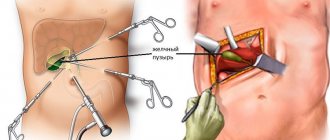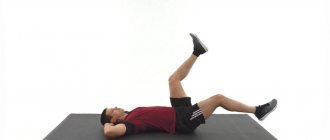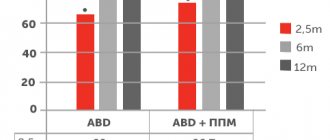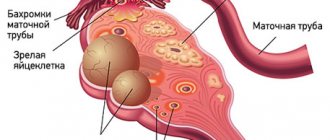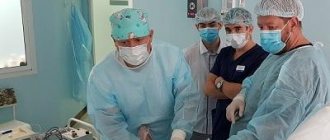In the article we will look at how compression stockings for surgery and childbirth differ from compression stockings for women and men, how to choose the size, why they are needed and how long to wear them after surgery.
So, your delivery or surgery is imminent. Most likely, you have already been wearing a prenatal bandage for some time; you will learn about bandages for the postpartum and postoperative period. In general, estimate how long the process of restoration of both internal and external organs of the body will take. If various types of ortho bandages are suitable for the abdomen, legs, back, chest, then a compression mask will help to restore the face. But the only question that remains is why to wear and how to choose compression stockings for surgery, childbirth, or caesarean section.
These stockings are generally called anti-embolic stockings. They are also called:
- generic;
- for a caesarean section;
- for a surgical operation;
- for women for gynecological surgery;
- medical, hospital stockings;
All these products are NOT DIFFERENT from each other in purpose and perform only one function - when staying in one lying position for a long time, they help the outflow of blood from the lower extremities, prevent congestion, and prevent the formation of blood clots. Compression products for surgery are labeled anti-embolic, which means in our case you can safely choose them.
How to choose the size of stockings for gynecological surgery, caesarean section, childbirth.
You may ask why stockings are needed for a caesarean or other operation if you can wear regular compression products for men or women. The differences between stockings for surgery are their features: open toe, color, compression and silicone insert. Due to the open toe, you can choose the size of the product without fear of error. An open toe will solve the problem of choosing a size. The sizes of anti-embolic stockings are selected according to the table. Each manufacturer has its own sizing chart. There are as many manufacturers of anti-embolic products as there are size tables.
Surgical method for treating varicose veins
In the treatment of varicose veins, both conservative therapy and surgical intervention are used. The latter is preferable, since medications and wearing special underwear, unfortunately, have a purely symptomatic or preventive effect without affecting the underlying cause of the disease.
However, with the combined use of conservative and surgical methods, the highest positive results are observed than with the use of only invasive operations.
A modern surgeon has several methods of surgical treatment of varicose veins in his arsenal. The most commonly used are the following:
- Laser-assisted microphlebectomy is a minimally invasive method. During it, the affected veins are removed through small skin incisions;
- stripping - removal of the venous trunk with a thin probe;
- sclerotherapy - injection into a vein of a drug with a special composition that provokes an inflammatory reaction, sclerosis in the venous lumen;
- laser and radiofrequency coagulation - with the help of radiation, the injured wall of the vein is “cauterized”, its lumen is closed;
- phlebectomy is the oldest, traditional method, during which the entire vein is removed (in case of pronounced pathology or ineffectiveness of minimally invasive methods).
So how many measurements do you need to take to make the right choice?
In more expensive models, to choose the correct size you need to take many measurements, including height and weight. In inexpensive models, including those from Russian manufacturers, the size is selected based on 2-3 leg measurements:
- ankle circumference;
- hip circumference at its thickest point.
The size of the foot itself is not involved in the choice, since the open toe fits any size.
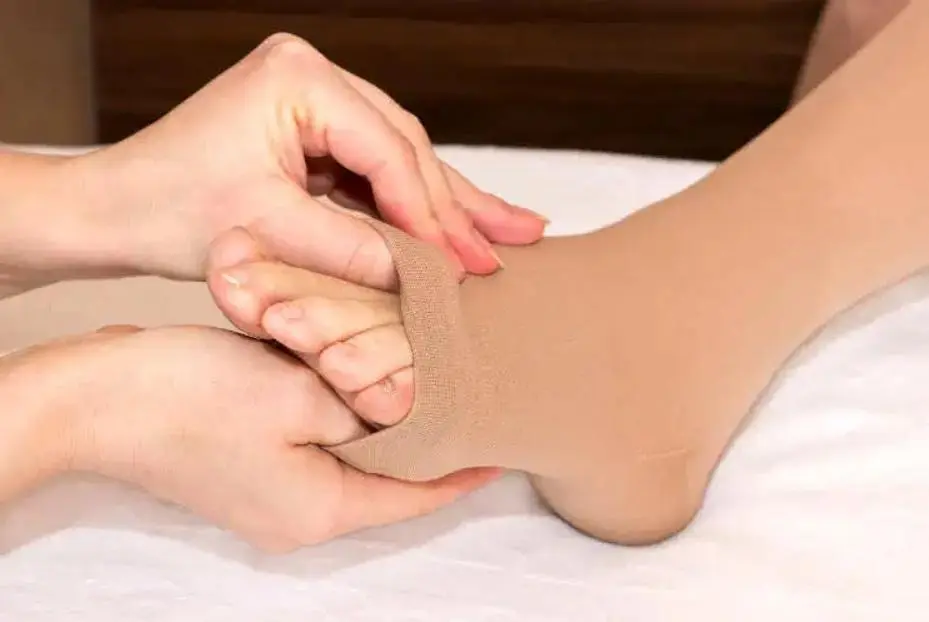
How many compression classes do operating hospital stockings have?
Distributed compression from the ankle to the thigh is not very pronounced or it simply does not exist. But the compression class itself remains the same as that of conventional compression knitwear:
| 1st class | 18-22 mmHg during short operations and without complications for the patient. |
| 2nd class | 23-33 mmHg during long operations, it is possible for 2 hours or more, with complications for the patient. |
| 3rd grade | 33-45 mmHg. class for severe complicated cases |
Who should wear it?
The method of diagnosis or surgical intervention using a laparoscope is used not only for gynecological problems, but also for diseases of other organs located in the abdominal cavity. Therefore, wearing hospital stockings is recommended for both women and men, for whom, by the way, models are produced that correspond to the male structure of the legs.
In 100% of cases, wearing compression hosiery is necessary for people over 40 years of age, as well as in the presence of the following pathologies:
- diseases of the blood coagulation system;
- phlebeurysm;

Varicose veins
- obesity or overweight;
- chronic heart disease;
- diabetes mellitus of any type.
In some private clinics, during laparoscopy, instead of stockings, a special compression device is used, which stimulates blood flow in the legs. However, after such innovative stimulation of blood flow, doctors will still recommend wearing tight knitwear.
How many days and what compression stockings to wear after surgery.
Anti-emolic products must be worn during the operation, but if there is indications from the attending physician, then after the operation, including caesarean section, you should continue to wear stockings. The patient himself decides, taking into account his condition and characteristics, how long to wear them after surgery. If you plan to spend a long time, you will have to choose another pair or two of regular compression stockings, taking into account size, color and comfort. But if you are not going to wear compression for a long time, you can use already purchased compression stockings.

Terms of use
- Skin must be completely dry before putting on. Lotion or cream will not make sliding easier, but will only complicate the process.
- Compression stockings are put on in the morning, while still lying in bed, with your legs elevated.
- You need to wear knitwear all day, take it off only before going to bed.
- If the fibers are damaged, stockings lose their function. Therefore, when putting on knitwear, you need to remove jewelry from your hands, and if you have long nails, it is better to wear gloves.
- The stockings hardly stretch and are difficult to put on. Therefore, until the proper dexterity is acquired, this must be done slowly and carefully. If you rush, the knitwear may twist, causing severe discomfort.
Still have questions? Call!

St. Petersburg, Olminskogo st., 5 Single telephone number
Request a call back
Choosing the color of compression and surgical stockings:
- white
- beige
- black
Often, manufacturers produce compression anti-embolic knitwear in white and are cheaper than similar products for everyday wear. Maternity compression stockings for caesarean section do not require long-term wearing. After surgery, they are not worn outside because they are usually white. Operating stockings often do not have distributed compression and wear resistance is low. The non-reinforced heel also makes them not very practical for everyday wear.
Less common are hospital stockings for surgery and beige in color; they can be worn after childbirth and after surgery, as well as on an airplane. It should be noted that they also will not have a strong difference in the degree of compression at the ankle and hip, although the compression class will remain.
Black maternity stockings, of course, are practical; there are no traces of blood or stains on them if there has been an operation. But medical workers do not recommend them, because compression stockings for surgery are hospital, medical stockings, which means they must be white.
Types of knitwear
Knitted products with a compression effect can be divided into several classes:
- Anti-varicose – therapeutic underwear is used for the treatment of varicose veins. Helps eliminate the symptoms of the disease even in the later stages of the pathology.
- Preventive – used if there is a predisposition to vascular diseases, they are necessary to prevent the development of pathology.
- Anti-embolic - compression garments after surgery, during intervention and childbirth prevent the occurrence of thromboembolism. To prevent embolism, congestion and hypotension, elastic products are worn for several days after surgery.
- Decongestants – indicated for use in patients with lymphatic stagnation.
A phlebologist will help you choose stockings for laparoscopy and abdominal surgery. Based on the condition of the blood vessels and the presence of chronic vascular diseases, the specialist will select orthopedic products and give recommendations for wearing.
Why do compression surgical stockings have a silicone insert, dots, and elastic on the thighs?
- Bandages are cheap and old.
- Stockings with an elastic band are easier to put on, they do not have a silicone insert, they are used less and less (they perform the function of surgical stockings well, although manufacturers sometimes hide the absence of silicone tape).
- Stockings with dots on the thigh are an ideal option - worn for surgery, and they are no longer needed. Points are the most common way of attaching anembolic products to the leg.
- The most reliable and expensive is one, two or three silicone tapes on the thigh. These will be regular compression stockings of 1st or 2nd degree compression. They stand well on their feet both during childbirth and during cesarean or gynecology. Can be worn during the postpartum and postoperative period. The most practical option.
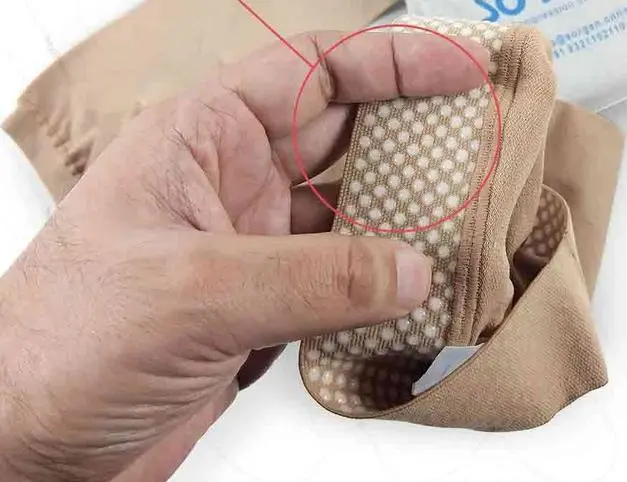
If you look at how hospital and medical knitwear developed, bandages appeared first. The second are stockings for surgery with a simple elastic band. They are easy to put on. The last to appear were stockings for operations, childbirth and cesarean sections with silicone drops, and the last ones were anti-embolic stockings with one, two or three silicone tapes for complex gynecological operations.
The price of the product directly depends on the number and width of the silicone inserts. Another important point in favor of choosing operating stockings with silicone tapes or inserts is that they can be worn after discharge from the hospital, if required for medical reasons.
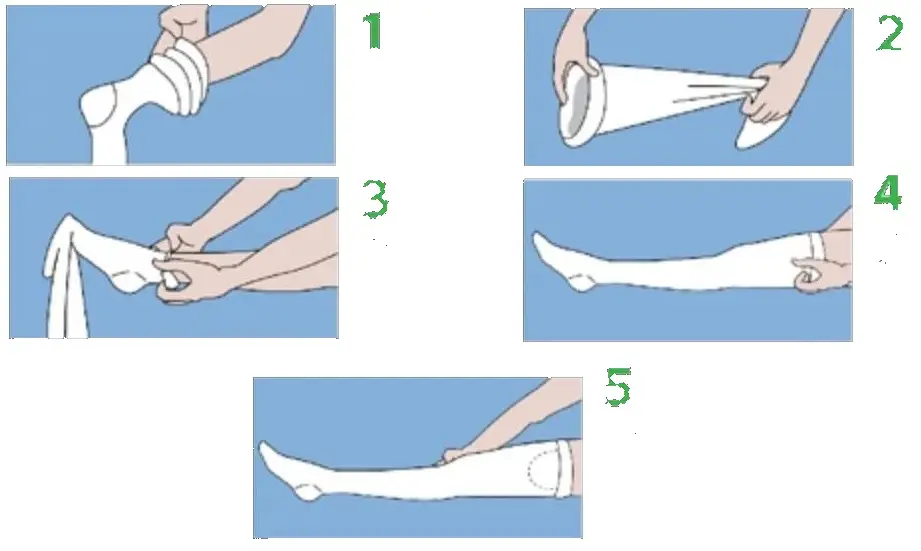
What to choose: open or closed toe (toe)?
- closed toe and heel
- open toe
- open toe and open heel
Everything is clear here. Closed toe is becoming less and less common and will suffer the same fate as bandaging - this option will not be used. Stockings with an open toe are more convenient for surgery because through the hole in the sock the doctor will be able to assess the patient’s condition, as well as relieve compression, for example in the ankle, if the product strongly compresses the leg. If the patient has large feet, then an open toe for surgical products will also be preferable. An open heel is rare, as the absence of a heel will result in a decrease in the amount of pressure.
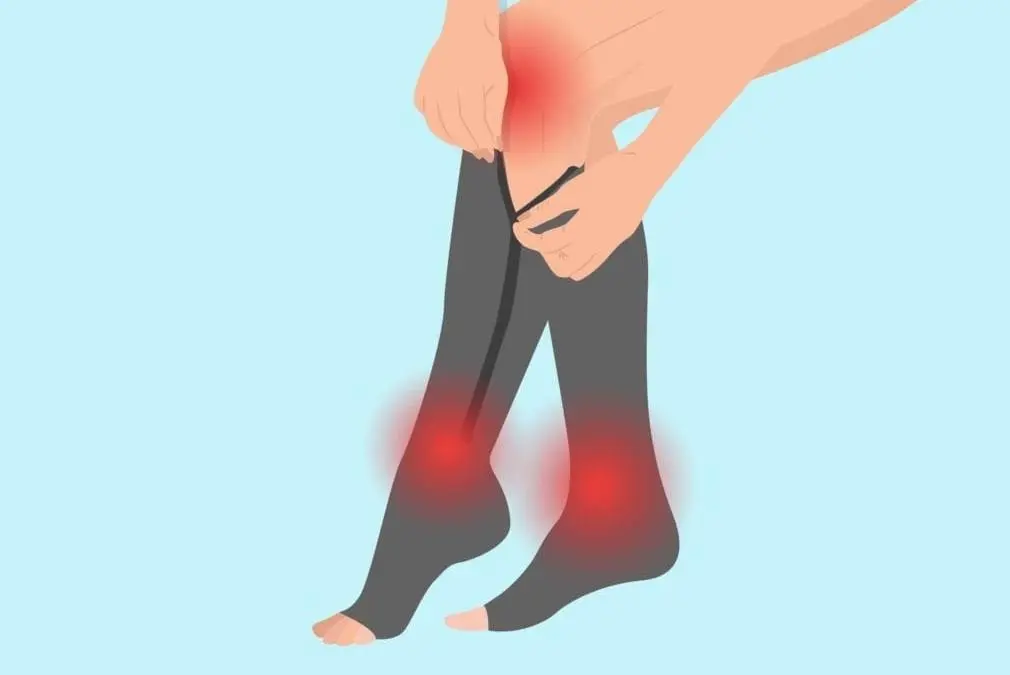
An open toe and heel is an interesting option, but then there will be no pressure on the heel, and the overall compression in the ankle area of the foot will decrease. This option is suitable in special cases on the recommendation of a doctor, and is associated with non-standard foot sizes
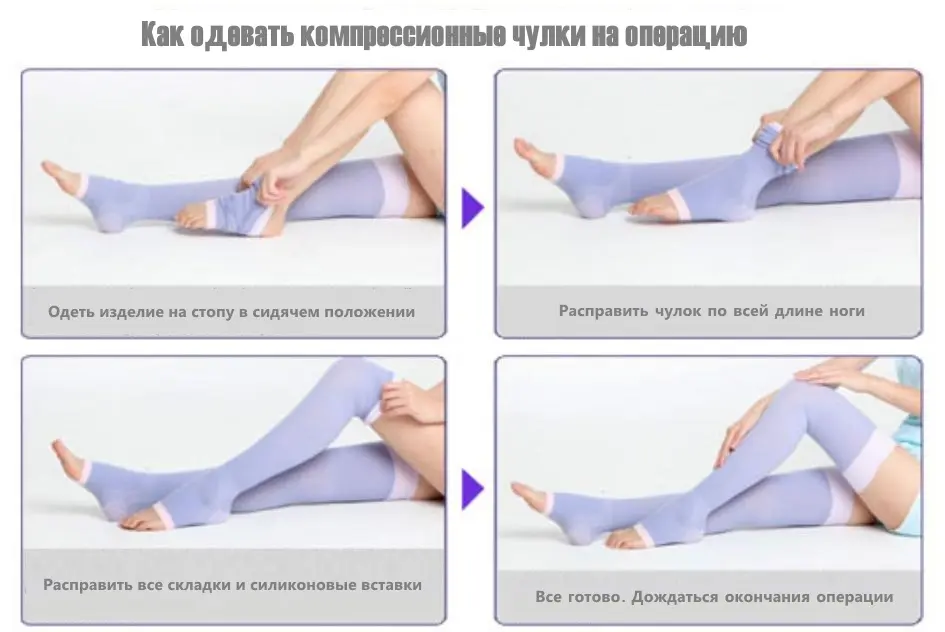
Operating medical stockings are needed for everyone who is preparing for surgery, childbirth or caesarean section. And for women in labor to preserve blood vessels in their legs during overload. If there are female prerequisites for varicose veins (after all, after carrying a heavy belly, veins in the legs often become visible) and for those who do not have them, so that this disease does not appear. After all, it is known that varicose veins are extremely difficult to cure, which means it is better to avoid it. During childbirth, no less pressure is exerted on the walls of blood vessels than before. And this is dangerous due to the formation of a blood clot and the consequences of its separation.
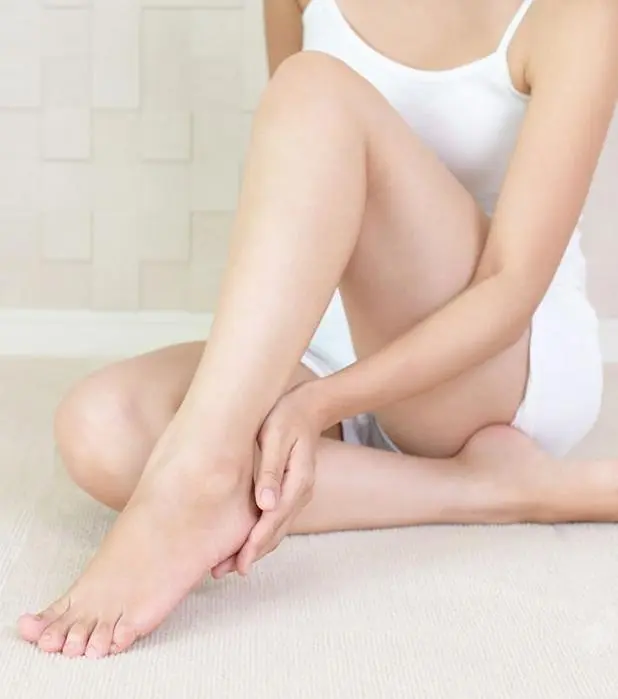
If you take into account all these tips, then your legs will easily bear all the burdens in a medical institution, and after discharge they will be even more beautiful than before.
